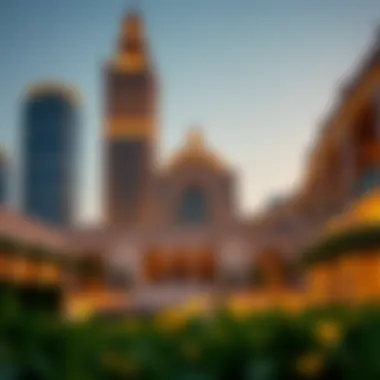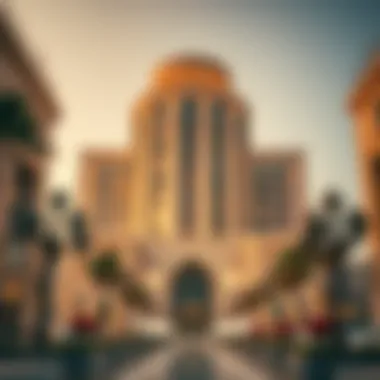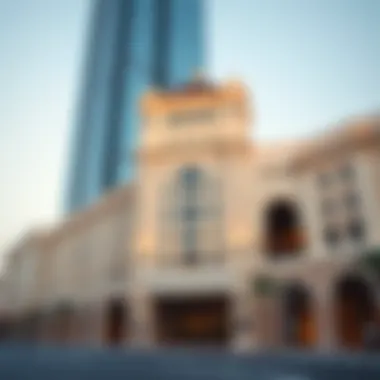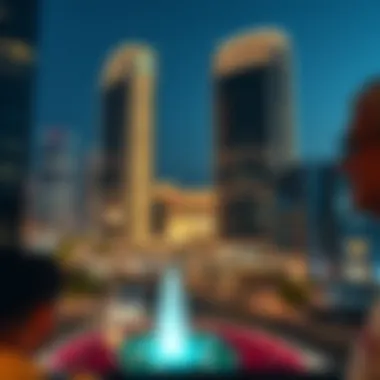Exploring the Architecture of Dirham Building in Dubai


Intro
Within the dazzling horizon of Dubai, where innovation meets tradition, the Dirham Building stands as a striking example of modern architecture infused with cultural significance. This building doesn’t merely add to the skyline; it represents a unique confluence of design ingenuity and local heritage. As the city continues to evolve, it becomes increasingly important to examine how structures like the Dirham Building contribute to the overall narrative of urban development in the UAE. In this article, we will explore its architectural nuances, navigate through the challenges faced during its construction, and reflect on its broader impacts in the real estate market.
Property Market Trends
Current Trends and Statistics
The real estate market in Dubai is a dynamic landscape, constantly shifting to accommodate both local and international investors. Recent trends indicate a thriving property market, with robust activity in residential, commercial, and mixed-use developments.
- Property prices have steadily increased, driven by a demand that shows no signs of waning.
- Rental yields in several neighborhoods are generating appealing returns for investors, making the Dirham Building an enticing opportunity.
- The influx of expatriates and tourists continues to bolster demand, creating a competitive market.
Moreover, according to the Dubai Land Department, transactions in 2023 have seen a noteworthy rise compared to the previous year. This uptick emphasizes the ongoing interest in Dubai's real estate as a sound investment, particularly in properties like the Dirham Building, which is strategically located and well-connected to business centers and amenities.
Future Market Predictions
Looking ahead, the forecasts predict a sustained growth trajectory in Dubai's property sector. Major events, including Expo 2024, are expected to further stimulate market dynamics. Analysts suggest:
- Continued improvement in infrastructure, coupled with government initiatives aimed at enhancing foreign investment, will positively impact property values.
- Properties located near key developments, such as the Dirham Building, might see appreciation as urban planning focuses on integrating residential spaces with commercial-industrial hubs.
- Economic recovery post-pandemic boosts consumer confidence, encouraging both local investors and international buyers.
The net result is a landscape ripe for investment, particularly for properties that are well-designed and architecturally significant.
Buying and Renting Properties
Essential Steps for First-Time Buyers
Navigating the property market can be daunting for first-time buyers, but a clear understanding of the process can pave the way to successful investments. Here are the essential steps:
- Determine Your Budget: Assess what you can afford, including additional costs like maintenance and service charges.
- Research Areas: Investigate various neighborhoods, focusing on those with robust amenities and good transport links.
- Engage a Lincensed Real Estate Agent: An expert can provide essential insights and negotiate on your behalf.
- Visit Properties: Don’t rely solely on photographs; visiting potential properties gives you a better sense of space and quality.
- Understand the Legal Process: Familiarize yourself with the paperwork involved, ensuring compliance with local regulations.
Renting Best Practices and Considerations
Renting a property in Dubai involves its own set of best practices to maximize your experience and minimize pitfalls:
- Read the Lease Agreement Thoroughly: Ensure you understand all terms, including duration, renewal options, and termination clauses.
- Consider the Location: Proximity to work and leisure amenities can greatly affect your quality of life.
- Inspect the Property Thoroughly: Always check for any damages and necessary repairs before signing anything.
- Communicate Openly with the Landlord: Establishing a good relationship can help with maintenance issues in the future.
- Review Market Rates: Stay informed about rental prices in your chosen area, so you can negotiate effectively.
By following these guidelines, both buyers and renters can make more informed choices, contributing to their long-term satisfaction in the bustling Dubai property market.
"Understanding the market landscape is key to making strategic decisions that align with personal or investment goals."
Intro to Dirham Building
The Dirham Building represents a pivotal point in Dubai's ever-evolving architecture landscape. It captures the essence of modern design while rooted in the historical context of the region. This section will explore the noteworthy features and significance of the Dirham Building, shedding light on its architectural approach and cultural implications. For investors, homebuyers, and real estate agents alike, understanding the value of such iconic structures is key to navigating the dynamic property market in Dubai.
Historical Context
Tracing back the threads of history, the concept of the Dirham Building emerges amid Dubai's transformation from a modest port town to a global hub of commerce and innovation. The foundation of the Dirham Building is intricately linked to Dubai's ambitions. Originally built to accommodate the increasing demand for commercial space, its location was strategically selected for accessibility and visibility.
The project commenced against a backdrop of rapid urbanization, which saw traditional structures yield to modern skyscrapers. Historical influences blend into this architectural marvel, paying homage to local traditions and the winds of change that define Dubai's identity. Architectural historians often remark on how the building reflects the juxtaposition of past and future frameworks within the city's urban fabric.


Architectural Concept
When gazing at the Dirham Building, one notices not merely a façade of glass and steel but an intentional design philosophy that evokes a sense of harmony between nature and nurture. The architectural concept hinges on principles of sustainability and functionality, aiming to create a space that caters to both professional and personal needs.
The building's exterior exhibits a seamless blend of contemporary design elements with nods to time-honored architectural styles prevalent in the region. Towering above its surroundings, the curved silhouettes and expansive views amplify its presence. Furthermore, the use of local materials speaks to an intrinsic understanding of the environment, offering a sense of place.
In terms of usability, the architectural layout boasts open-plan spaces, facilitating collaboration and innovation among tenants. This progressive design is key to attracting businesses that value flexibility and adaptability in the face of an ever-changing market.
Engaging with the Dirham Building's architecture extends beyond aesthetic appreciation; it invites a deeper contemplation of how physical spaces shape human interaction within a rapidly advancing metropolis. As such, the Dirham Building is not just a structural entity but an emblem of Dubai's cultural aspirations and economic vitality.
Design Elements of Dirham Building
Design elements play a pivotal role in any architectural structure, and the Dirham Building is no exception. This part of the article will explore various attributes that contribute to its uniqueness. Focusing on exterior aesthetics, interior design features, and sustainable design practices, we will breakdown how these elements not only define the building's identity but also enhance its significance in Dubai's urban landscape.
Exterior Aesthetics
The exterior of the Dirham Building serves as a striking visual statement against Dubai's iconic skyline. With its sleek glass facades blending seamlessly with bold structural lines, the design encourages a sense of modernity while respecting the environment around it. The use of reflective surfaces invites transient moments of light, enhancing the structure’s appeal during different times of the day.
Materials have been carefully chosen to withstand local climate conditions. High-performance glazing is prevalent, as it not only provides expansive views but also significantly contributes to energy efficiency. This melding of aesthetics with practical considerations elevates the building beyond mere utility.
Details such as intricate sunshades crafted from aluminum not only serve a functional purpose—reducing solar gain—but also add an element of visual interest to the building's exterior. These thoughtful design choices articulate the dual narrative of beauty and functionality, which is crucial in a market as competitive as that in Dubai.
"The Dirham Building stands out not just for its form but for the story it tells about the future of architecture in Dubai."
Interior Design Features
Walking into the Dirham Building reveals a carefully curated interior that echoes the elegance found in its exterior design. The lobby greets visitors with high ceilings, open spaces, and natural light filtering through massive glass windows. This creates a welcoming atmosphere reinforcing the notion of openness and accessibility.
Interior spaces have been designed with flexibility in mind. These adaptable environments cater to various functions, from corporate offices to communal lounges, reflecting the diverse needs of its occupants. Warm color palettes combined with minimalist furniture foster a sense of calm and professionalism, allowing for productive work environments.
Art installations sourced from local artists adorn the walls, connecting the building to its cultural context. This incorporation of artwork not only beautifies the space but also encourages community engagement and reflects the local heritage, transcending traditional boundaries of design.
Sustainable Design Practices
In a world increasingly focused on sustainability, the Dirham Building sets a benchmark for environmentally conscious architecture in Dubai. Various sustainable design practices were incorporated from the initial planning stages.
- The building boasts energy-efficient lighting systems that adapt based on the time of day, ensuring energy use aligns with occupancy levels.
- Rainwater harvesting systems collect and reuse water for irrigation and non-potable uses, effectively minimizing waste.
- Solarpanels installed on the roof create renewable energy, decreasing reliance on fossil fuels.
These elements are not merely buzzwords; they represent a commitment to creating a responsible structure that aligns profitability with environmental stewardship. Each decision made during the design phase underscores the urgent need for sustainable practices that could influence future developments in urban centers worldwide.
Construction Timeline
The construction timeline of the Dirham Building is not just a mere series of events; it’s the backbone that holds the entire project together. This segment of the article details how meticulous planning and strategic execution were critical in transforming vision into reality. Understanding the timeline gives insights into the challenges faced and the achievements celebrated, creating a comprehensive narrative about the building's significance in the wider context of Dubai’s urban landscape.
Planning and Approvals
Before the first stone was laid, an extensive planning process was initiated. Stakeholder engagement was prioritized, ensuring that local communities, government authorities, and potential investors had a chance to express their views. The approval from Dubai Municipality wasn’t just a formality; it was reflective of the meticulous bureaucracy underpinning major projects in the city. One crucial aspect that stood out during the initial stages was the emphasis on adhering to cultural and environmental standards. It wasn’t just about building a structure; it was about embedding it within the fabric of Dubai’s diverse community.
Major Construction Phases


As the green light was given, the construction unfolded in several significant phases. The foundation phase, for example, was not merely about digging deep, but rather, ensuring that the groundwork was sound enough to support a skyscraper. The engineering team deployed advanced techniques to guarantee stability, which was paramount given Dubai's unique geological challenges.
The timing of each phase was carefully calculated.
- Groundbreaking: Marked by a ceremony featuring local dignitaries, it set an optimistic tone.
- Structural Framework: Steel and concrete began to rise, reshaping the skyline; it was during this time that the impressive facade started taking form.
- Finishing Touches: This phase included everything from installing state-of-the-art technology to ensuring that every corner resounded with aesthetic appeal and functionality.
These phases manifest not just the physical growth of the Dirham Building, but also symbolize the progress of Dubai itself.
Challenges Encountered
However, no grand journey is without its hurdles. The timeline was not without delays, typically caused by the harsh weather patterns that characterize the Arabian Gulf. Extreme heat posed a significant challenge, leading to increased material costs and extended labor hours. Additionally, navigating through the regulations of building heights and land use added layers of complexity to the straightforward task of construction.
"Construction of monumental structures is akin to orchestrating a symphony—the harmony of engineering, architecture, and compliance must align perfectly for success."
As bringing together an intercultural workforce often resulted in communication hurdles. Language barriers and disparate work practices occasionally slowed progress. Despite these challenges, the ingenuity and resilience of the workforce ensured that construction was completed in a relatively timely manner, keeping sight on the overarching goal.
Ultimately, the timeline of the Dirham Building is not simply a record of days and months; it is a testament to innovation and collaboration amidst the complexities inherent in modern architecture. By unraveling this timeline, we glean insights that extend far beyond the realm of construction—insights into community impact, economic dynamics, and the ambitions driving Dubai into the future.
Economic Impact of Dirham Building
The considerations surrounding the economic impact of the Dirham Building extend far beyond mere aesthetics. This structure is a vital cog in the broader machinery of Dubai's urban ecosystem. By examining its myriad influences, we can discern not only how this building transforms the landscape but also how it engages with local economy, real estate, and community connection. Here, I will delve into three significant aspects: the real estate market dynamics, the influence on local businesses, and job creation potentials.
Real Estate Market Dynamics
The Dirham Building plays a prominent role in shaping the real estate landscape of Dubai. From an investor's lens, it signifies opportunity, as its presence often spurs demand in the surrounding areas. The location of this building can attract both residential and commercial prospects, acting as a magnet that draws potential buyers and tenants. Investors frequently eye such iconic structures for their ability to boost property values and invigorate neighborhood appeal.
Additionally, the building influences the types of developments that follow. When a landmark like the Dirham Building becomes a reality, it sets a precedent for other high-profile projects. New constructions nearby often resemble its innovative design, which can lead to a harmonious urban environment. As sentiment among investors shifts positively in response to such developments, one can expect a ripple effect across the real estate market, rejuvenating areas that might have needed a push.
Influence on Local Businesses
Local businesses acquire a distinct advantage in proximity to prominent buildings like the Dirham Building. The foot traffic generated by workers, visitors, and tourists can significantly contribute to the revenue of nearby shops and services. Coffee shops, restaurants, and retail outlets thrive on the increased patronage that comes from the bustling activity associated with major landmarks.
In particular, one can observe how bespoke establishments meticulously adjust their offerings to lure in customers who are part of or affiliated with the building's ecosystem. These ventures commence to evolve alongside the building, creating a symbiotic relationship that benefits both parties. For instance, a café that opens its doors next to the Dirham Building might cater to the 9-to-5 crowd, adjusting its menu according to seasonal trends and local tastes. This responsiveness not only fosters local economic growth but also enhances the community's cultural fabric.
Job Creation and Employment Opportunities
The construction and ongoing operation of the Dirham Building yield a multitude of job opportunities. During the construction phase, numerous trades and skill sets are required, ranging from architecture and engineering to skilled labor and project management. Many individuals, often from various backgrounds, find temporary employment, offering a wealth of experience in the construction sector.
Once the building is complete, job creation transitions to a new phase. With the establishment of businesses within its walls comes the need for staff. Positions in hospitality, retail, maintenance, and administration arise, contributing to a diverse job market surrounding the site. This transformation doesn’t just influence those directly at the Dirham Building; it can lead to broader employment opportunities across Dubai as ancillary businesses arise to support the needs of tenants and visitors.
The economic impact of the Dirham Building is profound, influencing real estate dynamics, boosting local business revenue, and creating a wealth of job opportunities that extend into the community.
In wrapping up this section, the Dirham Building’s presence extends its reach far beyond its architectural marvel. It catalyzes real estate movement, invigorates local businesses, and generates significant employment, all vital for a community thriving amidst the ever-changing skyline of Dubai.
Cultural Relevance
The cultural relevance of the Dirham Building extends beyond its architectural design and into the heart of Dubai's societal fabric. This structure doesn’t merely serve a functional purpose; it embodies the aspirations and traditions of a rapidly developing region. Its role in enhancing community identity and promoting a sense of belonging among residents cannot be understated. When people think of a place like Dubai, they also think of its landmarks that represent its culture and history—Dirham Building is one such landmark.
Community Engagement Initiatives


Community engagement initiatives tied to the Dirham Building are a vital aspect of its cultural impact. The developers have made strides to ensure that the building serves as a hub for social interaction, fostering connections among diverse groups. Regular community events are hosted, such as art exhibitions, cultural festivals, and educational workshops.
These gatherings not only allow residents to showcase local talent but also encourage dialogue between different cultures, reflecting Dubai's unique multicultural identity. For instance, workshops that focus on traditional Emirati crafts are often held, allowing both locals and expatriates to participate in cultural preservation. Additionally, spaces within the Dirham Building are designed specifically for community meetings, which further enriches the collective spirit.
Benefits of Engagement Initiatives
- Cultural Showcase: These initiatives highlight the rich traditions of the UAE, showcasing everything from local music to culinary arts.
- Social Cohesion: By engaging the community, these programs foster social ties, helping to bridge gaps between diverse populations.
- Increased Awareness: Residents gain a deeper understanding and appreciation of their community’s history and identity.
Art and Public Spaces
Art plays a crucial role in the cultural framework of the Dirham Building. The integration of art into public spaces within and around the structure not only beautifies the environment but also enhances the visitor experience. Local artists have their work displayed prominently, creating an ever-changing narrative within the building.
Public spaces imprinted with art encourage exploration and provoke thought among visitors. Moreover, installations that commemorate historical events or reflect societal values serve as educational tools, sparking conversations among onlookers about the deeper meaning behind each piece.
Key Aspects of Art Integration
- Sculptures and Murals: Bold sculptures and thought-provoking murals narrate stories central to Dubai's heritage and innovation.
- Interactive Installations: Pop-up art exhibits invite community interaction, turning passive viewers into active participants.
- Support for Local Artists: By prioritizing local talent, the Dirham Building strengthens the regional art scene, providing artists a platform to gain recognition.
Future Prospects
The significance of future prospects for the Dirham Building in Dubai is not merely tied to the immediate architectural features or economic insights. Rather, it emphasizes how this structure can pave the way for future advancements in both urban aesthetics and community integration. Addressing the evolving landscape of real estate and urban development, this section dives into the potential it holds in fostering sustainable growth, reflecting the values of a 21st-century metropolis.
Potential Developments
As the skyline of Dubai continues to evolve, the Dirham Building symbolizes a canvas for future developments that align with the city’s ambitious growth agenda. While it stands as a testament to modern design, it also opens the door to innovative projects that embrace emerging technologies and trends. Some anticipated developments include:
- Smart Building Technologies: The integration of Internet of Things (IoT) technologies may enhance energy efficiency, improving both comfort and sustainability in energy consumption.
- Vertical Gardens: Incorporating green spaces into urban settings could become a hallmark for future projects. This not only beautifies the skyline but also contributes to better air quality and enhances the well-being of residents and visitors.
- Mixed-Use Spaces: Future designs may continue to blend residential, commercial, and recreational facilities, ensuring that developments cater to varied lifestyle preferences, much like the Dirham Building is intended to do.
These potential developments are essential, as they not only enhance the building's utility but also contribute positively to the environment and community harmony.
Integrating with Urban Planning
Integrating the Dirham Building with urban planning initiatives is akin to stitching a quilt; every piece must fit harmoniously with the others to create a cohesive vision for the future. Effective urban planning around the Dirham Building can ensure that it doesn’t just exist in isolation but instead becomes a pivotal component of Dubai's architectural identity. Important considerations include:
- Transportation Accessibility: Ensuring that public transport systems, such as the Dubai Metro and bus services, facilitate easy access to the Dirham Building could significantly elevate its role within the community.
- Public Spaces: Designing surrounding public areas that encourage social interaction and recreational activities can make the building a vibrant part of the urban community, fostering engagement among residents and visitors alike.
- Cultural Integration: Future planning efforts should consider how the Dirham Building can celebrate local culture through art installations, community events, and architectural styles that honor Dubai’s heritage.
“A city is not just a physical space; it is a living entity that thrives through community engagement and planning.”
In essence, the future prospects of the Dirham Building are intertwined with the overarching narrative of Dubai’s growth. By acknowledging its potential for development and actively planning its integration within the urban fabric, stakeholders can help shape a progressive narrative that resonates with both investors and residents.
Closure
In wrapping up our exploration of the Dirham Building, it becomes clear that this structure is much more than a mere collection of steel and glass; it stands as a testament to Dubai's ambition and vision. The significance of this building lies not only in its architectural brilliance but also in its role within the wider socio-economic landscape of the United Arab Emirates.
Reflections on Dirham Building
Reflecting on the Dirham Building, it’s essential to consider how it embodies contemporary design principles while respecting the cultural and historical context of Dubai. The building’s striking design marries functionality with aesthetic appeal, showcasing an innovative use of materials and technology. Such architectural feats are pivotal as they set standards for future developments.
The community it serves has also benefitted greatly from its presence. The building has transformed the surrounding neighborhood, bringing in foot traffic and inspiring new businesses to flourish. Investors and homebuyers alike should not only consider the monetary value when looking at the Dirham Building, but also its cultural value and influence on local dynamics.
Implications for Future Projects
Looking ahead, the lessons learned from the Dirham Building's journey are invaluable for future real estate projects. Its construction faced numerous challenges, from navigating regulatory frameworks to integrating sustainable practices. These hurdles underline the importance of effective planning and adaptability in the face of adversity.
For future developments, there are several key takeaways:
- Sustainability Matters: As seen in the Dirham Building, incorporating sustainable design is not just a trend but a necessity that appeals to modern investors and residents alike.
- Community Focus: Engaging local communities throughout the planning and design stages can lead to successful projects that resonate with their environment and inhabitants.
- Innovation in Design: Embracing new technologies and innovative design approaches can set a project apart in a crowded market, making it an attractive option for prospective buyers.







